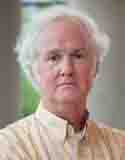David H. Hall, Ph.D.
Professor, Dominick P. Purpura Department of Neuroscience
(neuroscience category)

The soil nematode Caenorhabdidis elegans is a model system used to study the genetic control of cellular development. The Hall laboratory specializes in ultrastructural studies of the C. elegans. We use serial thin sections, electron microscopy, electron tomography, FIB/SEM and immunocytochemistry as primary tools to follow the development of identified neurons, particularly their axon outgrowth and synaptic connectivity. We also conduct collaborative studies on many other tissues in the embryo, larval, dauer, adult and aging nematode, including many epithelial tissues and the germline.
We host the Center for C. elegans Anatomy, supported by the NIH Office of the Director, and train students in anatomical methods for this system. Members of the lab are authoring the website www.WormAtlas.org. It displays nematode anatomy in great detail through multiple applications including Slidable Worm, a Handbook of all cells and tissues, the WormImage catalogue, a Glossary, and selected html texts of classic papers.
In collaboration with Scott Emmons, we are studying the complete connectome of C. elegans in both sexes and in larval stages to uncover how the nematode wiring diagram develops over time. In collaboration with Maureen Barr (Rutgers) we are studying the “tubulin code” which helps to stabilize ciliary microtubules during development and maintenance of the nematode’s sense endings.
Selected Publications
Whole-animal connectomes for both Caenorhabditis elegans sexes (2019) Cook, S.J., Jarrell, T.A., Brittin, C., Wang, Y., Bloniarz, A.E., Yakovlev, M.A., Nguyen, K.C.Q., Tang, L.T-H., Bayer, E.A., Duerr, J.S., Bülow, H.E., Hobert, O., Hall, D.H. & Emmons, S.W. Nature 571: 63–71.
Axon-Dependent Patterning and Maintenance of Somatosensory Dendritic Arbors (2019). Ramirez-Suarez NJ, Belalcazar HM, Salazar CJ, Beyaz B, Raja B, Nguyen KCQ, Celestrin K, Fredens J, Færgeman NJ, Hall DH, Bülow HE. Dev Cell. 48:229–244.
The AFF-1 exoplasmic fusogen is required for endocytic scission and seamless tube elongation (2018). Soulavie F, Hall DH, Sundaram MV. Nat Commun. 9(1):1741. doi: 10.1038/s41467-018-04091-1.
C. elegans neurons jettison protein aggregates and mitochondria under neurotoxic stress (2017) Melentijevic I, Toth ML, Arnold ML, Guasp RJ, Harinath G, Nguyen KC, Taub D, Parker JA, Neri C, Gabel CV, Hall DH, Driscoll M. Nature. 542: 367–371.
Cell-specific α-tubulin isotype regulates ciliary microtubule ultrastructure, intraflagellar transport, and extracellular vesicle biology (2017). Silva M., Morsci N., Nguyen K.C., Rizvi A., Rongo C, Hall D.H., Barr M.M.Curr Biol. pii: S0960-9822(17)30208-7
Glia-derived neurons are required for sex-specific learning in C. elegans (2015) Sammut, M., Cook, S.J., Nguyen, K., Felton, T., Hall, D.H., Emmons, S.W., Poole, R.J. and Barrios, A. Nature 526: 385–90.
Neurite sprouting and synapse deterioration in the aging C. elegans nervous system (2012) Toth, M., Melentijevic, I., Shah, L., Bhatia, A., Lu, K., Talwar, A., Naji, H., Ibanez-Ventoso, C., Ghose, P., Jevince, A., Xue, J., Herndon, L.A., Bhanot, G., Rongo, C., Hall, D.H., and Driscoll, M. J. Neurosci. 32: 8778-90.
The connectome of a decision making neuronal network (2012) Jarrell, T.A., Wang, Y., Bloniarz, A.E., Brittin, C.A., Xu, M., Thomson, J.N., Albertson, D.G., Hall, D.H. and Emmons, S.W. Science 337: 437– 444.
Stochastic and genetic factors influence tissue-specific decline in ageing C. elegans (2012) Herndon, L.A., Schmeissner, P.J., Dudaroneck, J.M., Brown, P.A., Listner, K.M., Paupard, M.C., Hall, D.H., and Driscoll, M. Nature 419: 788–794.